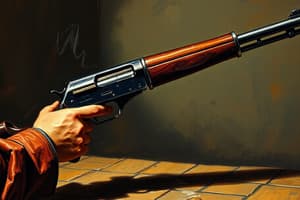Podcast
Questions and Answers
What defines an offensive weapon under Article 22 Public Order (NI) Order 1987?
What defines an offensive weapon under Article 22 Public Order (NI) Order 1987?
- A tool that has been used in an attack regardless of its intended use.
- Any weapon that is illegal to carry in public places.
- An item that can theoretically cause injury but is not designed for that purpose.
- An article made or adapted for use to cause injury, or intended for such use. (correct)
Which of the following items is considered made as an offensive weapon?
Which of the following items is considered made as an offensive weapon?
- A kitchen knife that has been sharpened.
- A baseball bat that has been altered with nails.
- A flick knife manufactured for cutting. (correct)
- A flower pot used as a projectile.
What is the maximum penalty for possession of an offensive weapon upon indictment?
What is the maximum penalty for possession of an offensive weapon upon indictment?
- 4 years' imprisonment. (correct)
- 6 months' imprisonment.
- Community service of 300 hours.
- A fine up to £5000.
Which of the following items would NOT qualify as an adapted offensive weapon?
Which of the following items would NOT qualify as an adapted offensive weapon?
What burden of proof lies on a person carrying an offensive weapon in a public place?
What burden of proof lies on a person carrying an offensive weapon in a public place?
How are weapons generally classified in legislation regarding offensive weapons and blades?
How are weapons generally classified in legislation regarding offensive weapons and blades?
Which legal case involved a broken bottle used to cause injury and helped define adapted weapons?
Which legal case involved a broken bottle used to cause injury and helped define adapted weapons?
What distinguishes a hybrid offence regarding possession of an offensive weapon?
What distinguishes a hybrid offence regarding possession of an offensive weapon?
Under what circumstances did the individual not have a reasonable belief for self-defense?
Under what circumstances did the individual not have a reasonable belief for self-defense?
What constitutes a corrosive substance as per the law?
What constitutes a corrosive substance as per the law?
What is an acceptable defense against the charge of having a corrosive substance in public?
What is an acceptable defense against the charge of having a corrosive substance in public?
What type of offense is the possession of a corrosive substance in a public place classified as?
What type of offense is the possession of a corrosive substance in a public place classified as?
What is the maximum imprisonment term for a summary conviction for the possession of a corrosive substance?
What is the maximum imprisonment term for a summary conviction for the possession of a corrosive substance?
What is the primary concern of the legislation regarding offensive weapons?
What is the primary concern of the legislation regarding offensive weapons?
Under what circumstances can a folding pocketknife be subject to the law on possessing an article with a blade or point in public?
Under what circumstances can a folding pocketknife be subject to the law on possessing an article with a blade or point in public?
If a person is charged with having an article with a blade in a public place, what can serve as a defense?
If a person is charged with having an article with a blade in a public place, what can serve as a defense?
Which item would NOT typically be considered an offensive weapon under the definitions provided?
Which item would NOT typically be considered an offensive weapon under the definitions provided?
What must the prosecution prove when someone is charged with the intention of causing injury using an innocent item?
What must the prosecution prove when someone is charged with the intention of causing injury using an innocent item?
What is the maximum punishment for the hybrid offense under the section related to possessing an article with a blade in public?
What is the maximum punishment for the hybrid offense under the section related to possessing an article with a blade in public?
Which of the following scenarios qualifies as lawful authority for carrying an article with a blade in public?
Which of the following scenarios qualifies as lawful authority for carrying an article with a blade in public?
What considerations do the police need to gather as evidence regarding the defendant's intention?
What considerations do the police need to gather as evidence regarding the defendant's intention?
What does Section 139B allow a Constable to do on school premises?
What does Section 139B allow a Constable to do on school premises?
Which of the following is NOT considered a reasonable excuse for possessing an offensive weapon?
Which of the following is NOT considered a reasonable excuse for possessing an offensive weapon?
In which case was a taxi driver's forgetfulness considered a possible reasonable excuse?
In which case was a taxi driver's forgetfulness considered a possible reasonable excuse?
What principle was established in the case of Bayliss v DPP 2003 regarding forgetfulness?
What principle was established in the case of Bayliss v DPP 2003 regarding forgetfulness?
Which of the following defenses was discussed as potentially acceptable regarding possession of weapons in specific contexts?
Which of the following defenses was discussed as potentially acceptable regarding possession of weapons in specific contexts?
What type of force may a Constable use when executing the powers granted under Section 139B?
What type of force may a Constable use when executing the powers granted under Section 139B?
Why might a person's previously tested reasonable excuse still result in conviction?
Why might a person's previously tested reasonable excuse still result in conviction?
What does NOT constitute a reasonable excuse based on learned defenses?
What does NOT constitute a reasonable excuse based on learned defenses?
What must a defendant prove when accused of possessing an offensive weapon?
What must a defendant prove when accused of possessing an offensive weapon?
In which case was it held that the defendant's state of mind should be considered by the court?
In which case was it held that the defendant's state of mind should be considered by the court?
What does the phrase 'has with him' emphasize in the legislation concerning weapon possession?
What does the phrase 'has with him' emphasize in the legislation concerning weapon possession?
What must be established for a reasonable excuse to be valid in the context of weapon possession?
What must be established for a reasonable excuse to be valid in the context of weapon possession?
Which of the following scenarios would not constitute an offence of weapon possession?
Which of the following scenarios would not constitute an offence of weapon possession?
Under what condition can multiple individuals be considered as having a single weapon 'with him'?
Under what condition can multiple individuals be considered as having a single weapon 'with him'?
What standard is used to judge the burden of proof for the defendant in weapon possession cases?
What standard is used to judge the burden of proof for the defendant in weapon possession cases?
Which of the following is true about the reasonable excuse defense in weapon possession cases?
Which of the following is true about the reasonable excuse defense in weapon possession cases?
Flashcards are hidden until you start studying
Study Notes
Offensive Weapons
- The term "offensive weapon" refers to a range of items used to cause harm.
- The legislation classifies two groups:
- Offensive weapons - Article 22 Public Order (NI) Order 1987 (made or adapted to cause injury)
- Blades/Sharp Points - Section 139 Criminal Justice Act 1988
- Carrying an offensive weapon is distinct from using it.
- Possession of an Offensive Weapon:
- Definition: Having an offensive weapon without lawful authority or reasonable excuse in a public place is an offense.
- Hybrid offense: Triable either way (summary or indictment).
- Penalties:
- Summary: 6 months imprisonment and/or a £5000 fine.
- Indictment: 4 years imprisonment.
- Offensive Weapon Categories:
- Made: Items manufactured specifically for causing injury, examples:
- Knuckleduster
- Flick knife
- Butterfly knife
- Baton
- Bayonet
- Adapted: Items altered to cause injury, examples:
- Baseball bat with protruding nails
- Sharpened coin
- Broken bottle with jagged edges
- Potato with inserted razor blades
- A JIF bottle filled with ammonia (not considered adapted)
- Intended: Items used for causing injury, examples:
- Snooker cue
- Hammer
- Intended Victim: The offense applies even if the intended victim of the weapon is the person carrying it.
- Made: Items manufactured specifically for causing injury, examples:
- Proof of Intent:
- The prosecution must prove the intent to cause injury for intended weapons.
- Evidence includes:
- Circumstances of the incident
- Police observations
- Witness statements
- Defendant's statements (before/after caution and during interview).
Blades/Sharp Points
- Section 139 Criminal Justice Act 1988: Prohibits possession of a bladed article or sharply pointed item in public places.
- Exemptions:
- Folding pocketknife (unless cutting edge exceeds 3 inches).
- Work purposes.
- Religious reasons.
- National costume.
- Defenses:
- Good reason or lawful authority.
- Using the article at work.
- Religious reasons.
- National costume.
- Hybrid offense: Triable either way.
- Penalties: Same as offensive weapon offenses.
- Burden of Proof:
- The defendant must prove they had lawful authority or a reasonable excuse for possessing the weapon.
- Examples of Reasonable Excuse:
- Retrieving a weapon from a violent scene to take to a police station.
- Forgetfulness:
- Not a reasonable excuse if the reason is forgetting the weapon existed.
- May be considered reasonable in cases where forgetfulness is due to illness or medication.
- Carrying a weapon for self-defense:
- Not reasonable as a general precaution.
- May be reasonable if there are credible threats of unlawful attack.
- Other circumstances:
- A person dressing up as a police officer and carrying a baton could be considered a reasonable excuse.
- A person picking up a metal bar to defend themselves after a recent threat is often not considered a reasonable excuse (N v DPP 2011).
Corrosive Substances (Offensive Weapons Act 2019)
- Offense: Possessing a corrosive substance in a public place is illegal.
- Definition:
- Corrosive substance: Any substance which can burn human skin via corrosion.
- Public place: Any place accessible to the public.
- Defenses:
- Good reason or lawful authority.
- Use at work.
- Hybrid offense: Triable either way.
- Penalties:
- Summary: 6 months imprisonment and/or a fine (maximum allowed).
- Indictment: 4 years imprisonment and/or a fine.
Legal Procedures
- Section 139B of the Act: Constables with reasonable grounds to believe an offense is being committed or has been committed regarding blades/sharp points can:
- Enter school premises.
- Search the premises and individuals.
- Seize potentially illegal items.
- Use reasonable force when necessary.
- Evidence:
- Many defenses to these offenses have been tested in court.
- Prior court cases are helpful for understanding the offense but do not guarantee a similar outcome in new cases.
- Courts retain discretion in making decisions based on the specific circumstances and evidence of each case.
Key Points to Remember
- The law focuses on preventing individuals from arming themselves with weapons.
- The "has with him" phrase emphasizes the offense centers around carrying weapons, not necessarily their intent.
- More than one person in a group can be deemed to "have with them" a single weapon if they are aware of its existence.
Studying That Suits You
Use AI to generate personalized quizzes and flashcards to suit your learning preferences.




